Published
on 27
Mar 2020
|
All rights reserved.
|
|
|
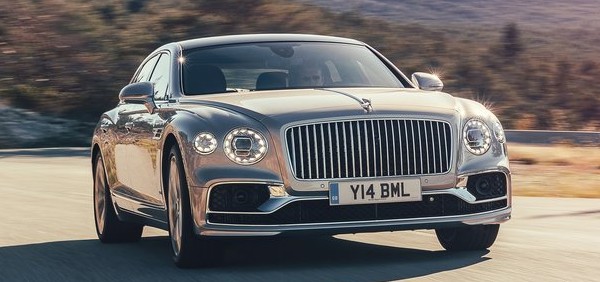
|
|
Now
based on Porsche platform, the Flying Spur is set to take off, finally.
|
|
Ultra-luxury limousine is
a very exclusive segment. Basically, only 3 marques compete in the
segment whose global volume amounts to only 8,000 units a year:
Rolls-Royce, Bentley and Mercedes-Maybach. To ordinary people like us,
we can never understand the attraction of these huge,
cumbersome-looking, excessively decorated and conservatively designed
machines to the richest people in the world. We admire somebody driving
a Mercedes S-class or BMW 7-Series, even more in case of a Jaguar XJ or
the last Pininfarina-designed Maserati Quattroporte, but seeing an old
fat guy sitting at the back of a Rolls-Royce? We just think how stupid
he is! When you need to show off your wealth by owning more of
everything – more metal, more wood, more leather, more c.c., more
cylinders and more zeros in its price tag – you are actually a poor
guy. Quoting a famous line from a Hong Kongese comedian, “you are so
poor that all you left is money!”.
Yes, just more of everything is not sufficient. What makes a luxury
limousine great is taste and character. Rolls-Royces are just mobile
houses that move its occupants with the least distraction. Maybachs are
not exclusive enough to warrant an exclusive price tag. Only Bentley
has the tasteful look and character to win the hearts of car lovers.
The late Ferdinand Piech was right. When he bought Rolls-Royce from
Vickers, he sold the Rolls-Royce name to BMW quickly, because in his
eyes the jewel in the crown has always been Bentley and the
craftsmanship of Crewe. Unlike Rolls-Royce, Bentley is designed to
delight drivers. It has to be fast. It has to handle its mass better
than it has any rights to be. It has to look desirable inside and
outside. And it has to feel very British, of course.
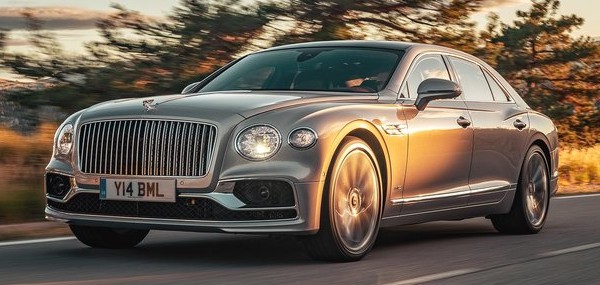
|
|
Styling
has more taste and character than either RR or Maybach.
|
|
Admittedly, not all Bentleys since the 1998 acquisition were good
Bentleys. The first 2 generations of Flying Spur (or Continental Flying
Spur as originally known) were more like a repackaged Volkswagen
Phaeton. Dynamically boring and aesthetically dull, they were not even
luxurious enough to beat Mercedes S-class. The best Bentley has always
been the largest: the Mulsanne and its predecessor Arnage. They showed
the most tasteful styling, the best craftsmanship and a traditional
6.75-liter OHV turbocharged V8 – though largely modernized in 2002.
However, the flagship model finally comes to the end of road now,
partly due to the cost it would take to modify the old engine to comply
with emission regs, partly due to the limited sales volume that fails
to justify an update, partly down to the market shift towards SUVs, a
trend Bentley already capitalized with Bentayga. As the Mulsanne has
gone, the new generation Flying Spur takes the responsibility to
represent the best limousine offered by Crewe. It has unlimited room to
grow more luxurious.
Firstly, it gets a far more graceful look. A prominent grille, muscular
fenders, large and small jewel-effect headlights, high-curvature
surfaces surrounding the headlights that need superformed technology to
shape the aluminum sheets… this car look significantly more
characterful than its jellyfish-like predecessor. Sportier and more
classical, too. The front end has real presence, although the tail is
less special.
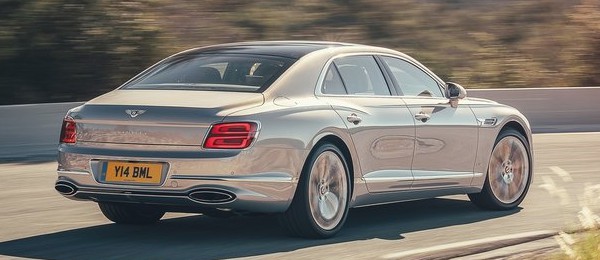
|
|
207mph
makes it the world’s fastest 4-door saloon.
|
|
Although the new car is barely longer and wider than its predecessor,
you will notice a very different proportion. Its front overhang is
shortened and the front axle is pushed forward, lengthening the
wheelbase by 130mm. This is because the new car is built on the
Porsche-developed MSB platform, which underpins also Panamera
and Continental GT, rather than the old Volkswagen
platform. The MSB ditches the old car's Quattro-based 4WD system
for the rear-biased 4WD system of Panamera. It is normally
rear-driven, but in case of need an electrohydraulic multi-plate clutch
can send up to 53 percent torque (or 31 percent in Sport mode) to the
front axle. This new layout allows the engine to be
positioned in the center of the engine compartment instead of at the
front overhang, improving weight distribution hence handling a lot. The
front-to-rear balance is now 54:46 instead of the previous 56:44, while
polar moment of inertia is also reduced. Like Continental GT, the
chassis here is made of a mixture of high-strength steel, aluminum
castings and extrusions. Outside, the body work is all-aluminum.
The launch engine is the 6.0-liter twin-turbo W12 of Continental GT. It
features cylinder deactivation, automatic stop-start and dual-mode
injection, although emisson is still far from acceptable (337g/km).
Maximum output is 635hp and 664lbft, with the
latter available from as low as 1350 rpm. Unusually for a luxury car,
it employs not a torque converter automatic transmission but the
8-speed twin-clutch gearbox of Porsche Panamera. Bentley spent a lot of
development to make sure it shifts as smoothly as a true automatic,
while delivering superior response when you demand. Despite a kerb
weight
in excess of 2.4 tons, the Flying Spur flies, taking only 3.7
seconds to go from 0-60 and topping 207mph – the latter makes it the
world’s fastest 4-door saloon! Later on, a 550hp twin-turbo V8 will
join the range.
Apart from active 4WD, the new Flying Spur gets 4-wheel
steering, too, which is the first Bentley to do so. It helps shortening
the turning circle in town and makes the large car more agile in the
twisty, while enhancing high-speed stability further. In the
suspension, its air springs have been upgraded to 3 chambers for a
broader range of adjustment. The suspension is
not only height-adjustable but also comes with adaptive dampers and
electric active anti-roll bars, whose 48V electrical system will
benefit the upcoming V6 plug-in hybrid
option. The Flying Spur employs huge wheels measuring either 21 or
22-inch. The mega-size 420mm steel front brakes with 10-piston calipers
come straight from the Continental GT.
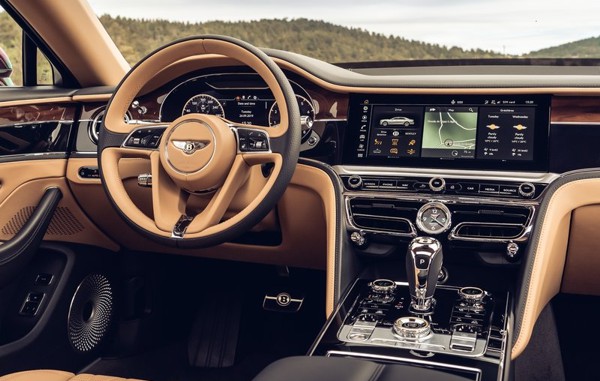
|
|
Far
more tasteful than a £360,000 Rolls-Royce Phantom...
|
|
The flagship Flying Spur starts at just under £170,000, but its
interior looks far more tasteful than a £360,000 Rolls-Royce
Phantom. Sharing genes with its Continental GT sister, its dashboard is
sleek, modern and sporty among its peers, yet the craftsmanship is
impeccable. Instead of the solid walnut on Mulsanne, it uses lacquered
veneers based on aluminum panels to form the dashboard surfaces. There
are many types of veneer textures to choose from, including 2-ton
treatment, all look great and expensive. Quality stitched leather wrap
the remaining surfaces. The center console is heavy on chrome. Take a
closer look, you will be amazed to see most of the chrome elements, no
matter the clock, rotary controls or liners, have diamond-shape
patterns rolled on. This is mirrored at the diamond quilting on the
door trims. The details are really amazing.
As in its coupe sister, the upper center console is a Toblerone-shaped
rolling device which may switch among a clean veneer panel, 3 analogue
gauges or a 12.3-inch touchscreen. The infotainment comes from
Volkswagen group’s parts bin, of course, but you won’t know that,
because the interface is unique and the operation is slick.
The Flying Spur takes good care of its rear passengers, too. There is a
champagne refrigerator, a remote control for the climate and
entertainment system, individual touchscreens, massaging seats, ambient
lighting and high-end audio system. However, the rear cushions seem a
little short for tall passengers, and the view outside is limited by
the smaller windows. Moreover, it does not offer airliner chairs like
Rolls-Royce or Maybach, so it might struggle to please that big fat guy
sitting at the back of Rolls-Royce. As luxurious as it is, the Bentley
is still designed primarily for driven.

|
|
Driving
enthusiastically, it becomes an M5 of the limousine world.
|
|
And we must say it drives amazingly well. With the heavier W12, this
flagship model might not be the best driving Flying Spur, as we found
on Continental GT, but even in this state it is easily the best driving
luxury limousine ever. And we are not just talking about against
Rolls-Royce or Maybach, but also against a Mercedes-AMG S63 4matic!
Bentley makes a good point to base the car on the Porsche platform. It
is well balanced. It feels rear-driven. It even feels quite agile on
winding roads, thanks to the rear-wheel steering. In Sport mode its
active anti-roll bars keep its body movement to the minimum without
hurting ride quality. Its massive brakes offer reassuring stopping
power. No cars such big can feel so sporty, so entertaining to drive.
If BMW builds a true M7 – definitely not the current M760Li, it has to
learn from Bentley.
In Comfort mode, the air suspension allows it to ride over undulations
smoothly, gliding along highway in silence. In Sport mode, it gets
harsher on less perfect surfaces, fine for a performance saloon but not
what you would expect on a limo. The best compromise is the “Bentley”
mode, in which the ride is smooth enough yet body movement is well
contained. Avoid the optional 22-inch wheels and you’ll be happy to
cruise in the car all day.
The familiar W12 delivers effortless performance at any revs. Its sound
is not particularly attractive, but it is smooth and massively
powerful. The 8-speed dual-clutch gearbox does the job as smoothly as a
torque converter automatic in most situations, though in certain
circumstances, such as sudden on/off throttle, reveals some rough
edges. In Sport mode, it serves up quick and smooth gearchanges.
What makes the Flying Spur different is its dual-personality. Driving
leisurely, it is almost as smooth and comfortable as a Rolls-Royce.
Driving enthusiastically, it becomes an M5 of the limousine world. This
is what an Audi S8 is supposed to show, but surprisingly, it is
realized by its British relative.
|
Verdict:      |
Published
on 4
Feb 2021
|
All rights reserved.
|
|
Flying Spur V8
|
|
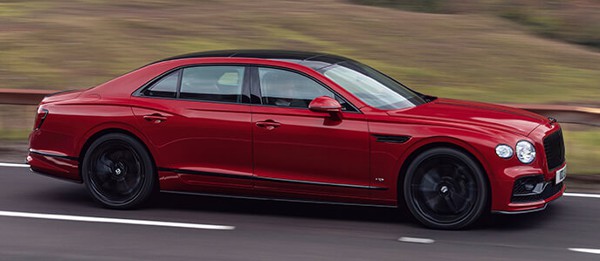
|
|
When
you cannot by a Bentley with engine anymore, you will miss it.
|
|
As in the case of the
Continental GT or the last generation Flying Spur, the V8 option is
actually better than W12, even if you ignore the 10-percent lower
price. You’ll sacrifice a little bit performance – 0-60 mph
acceleration takes 0.3 second longer, top speed drops by 9 mph, but you
still get as much as 198 mph in reserve and an acceleration almost
matching a base 911 Carrera. You’ll lose a bit low-end response, as the
4-liter V8 makes its 568 lbft of peak torque at 2000 rpm, while the
6-liter W12 supplies 664 lbft from merely 1350 rpm. Its two
turbochargers take a little more time to spool up, despite hot-Vee
architecture and twin-scroll design. However, once committed to
throttle, the V8 never disappoints, providing endless push while
revving smoothly and effortlessly. The exhaust note of the V8 is easily
more characterful than that of the whisper-quiet W12, especially at
high revs. It is not as expressive as the application on Continental GT
though, thanks to more sound insulation used throughout the Flying
Spur’s cabin. The 8-speed dual-clutch gearbox serves this motor just as
well as the W12, so well that you are rarely aware that it is not a
conventional torque-converter automatic.
Handling is certainly an improvement. The V8 carries 107kg less weight
than the W12, and most of it comes from the front axle. It is therefore
slightly better balanced, more agile and keener to turn. If it were
built on the old Volkswagen D1 platform, that might not be a
game-changing improvement. Since this generation is built on the
Porsche-developed MSB platform with more sensible weight distribution
and rear-biased running gears, we are talking of a dynamism good enough
to warrant the new Flying Spur a place in luxury car history. Its body
control is remarkable, thanks in part to active anti-roll bars but also
expert-judged suspension tuning. Its agility is beyond the reach of any
other luxury limousines, thanks to rear-wheel steering but also the
inherent balance. Meanwhile, ride comfort and noise management are
still worthy of the Bentley name, if not quite the level of Rolls-Royce
or Mercedes-Maybach. It is just a matter of priorities.
Unlike its rivals, Bentley is always supposed to be as much a driver’s
car as a passenger’s car. If you still love driving, it is definitely
the one to have. Unfortunately, the driver appeal of Bentley is going
to diminish over the next decade. From 2026, Crewe will build only cars
powered by electrified powertrains (plug-in hybrid or battery). By
2030, all kinds of internal combustion engines will be withdrawn from
its production, turning Bentley into a zero-emission marque. In other
words, this Flying Spur will be the last generation powered by engines,
producing proper induction noise and exhaust note, delivering a
mechanical feel that electric systems can never replicate. The V8 is
likely to last until the final day, and I am sure people will miss it a
lot.
|
Verdict:      |
Published
on 16
Jan 2025
|
All rights reserved.
|
|
Flying Spur Speed (hybrid)
|
|

|
|
The
best limousine in the world gets even better.
|
|
Bentley Flying Spur gets a
new range-topping model, Speed. Like its coupe sibling Continental GT
Speed, the limousine is powered by the firm’s new plug-in hybrid
powertrain consisting of a 600 hp 4.0-liter twin-turbo V8, a 190 hp
electric motor housed in dual-clutch transmission and a boot-mounted
25.9kWh battery pack. Combined output is a staggering 782 hp,
accompanied with 737 lbft of torque. This boosts its performance
significantly. 0-60 mph takes only 3.4 seconds, 3/10ths less than the
outgoing W12 model, although top speed is now capped at 177 mph instead
of its predecessor’s unrestricted 207 mph. The battery gives an
electric range of 76 km or 47 miles and lower CO2
emission rating to 33
g/km (assuming you recharge the battery full before each journey). The
car gains about 200kg, pushing its kerb weight to a new height of 2646
kg.
On the road, the hybrid powertrain suits the Flying Spur very well. It
starts with electric power alone, so delivers a silent running until
you press the throttle beyond 75 percent of its travel or when the car
hits 87 mph. However, without exhaust note you’ll hear more of the wind
noise, which is not quite as well insulated as
Rolls-Royce. When the battery dries out, the V8 joins forces smoothly.
The two power sources are well blended to deliver a strong and seamless
acceleration. The electric power is configured to fill in the torque
gap during each gearshift, so the DCT feels just as refined as a torque
converter automatic. Yes, the Speed is very very quick, more than any
one needs for a
luxury limousine. Only sports saloons like AMG S63 or Panamera Turbo S
– both are also plug-in hybrid – can topple it.
By using a lighter V8 engine and placing the battery at the back
improves weight distribution a lot, so the car doesn’t seem any
heavier. On the contrary, it feels a bit better balanced and more agile
in corner than the old W12. In Sport mode it can even display some
throttle adjustability, although no one would try that on a public
road.
Like Continental GT Speed as well, the Flying Spur has its suspension
updated with 2-chamber air springs (instead of 3) and dual-valve
adaptive dampers which can adjust compression and rebound rates
independently. This results in a noticeably smoother ride in Comfort
mode while maintaining body control in Sport.
The Flying Spur used to be the best luxury limousine in the world for
those driving the car themselves. The powertrain and suspension update
in the Speed solidifies its status further. Bentley has not altered the
rest of the car this time, which is fine, because the car remains
beautifully sculpted and crafted inside and out. The only drawback is
the battery eats a large part of the boot, reducing its volume to
merely 346 liters. At nearly £230,000 it is significantly more
expensive than an AMG S-class, but it feels classier, more bespoke and
therefore worth the extra.
|
Verdict:      |
|